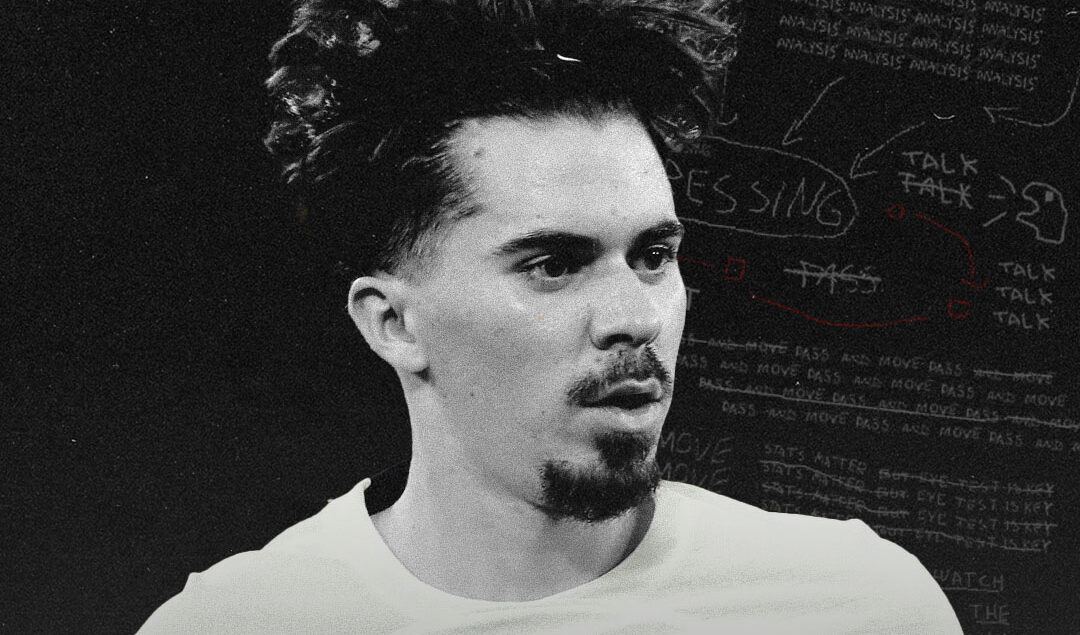Inter vs PSG: A Dance of Discipline and Daring
Inter Milan and Paris Saint-Germain are both on the short-list of Europe’s most tactically mature teams. Inter play a rigorously structured 3-5-2, every movement choreographed. PSG’s shape is looser, but they thrive on quick passing interplay and moments of individual brilliance.
At last, the two sides meet in the final showdown for Europe’s crown. After knocking out heavyweight contenders Arsenal and Barcelona in the semis, only one question remains: whose hands will lift the trophy in the end? This analysis breaks down each team’s shape, possession structure, pressing patterns, and final-third movement to paint a picture of how the match may look on a tactical level.
Inter Milan: Play Style
Structure and Positional Fluidity
On paper it is a 3-5-2, but depending on game state, it often becomes a 3-1-4-2 in possession and a 5-3-2 out of possession. Inter coach Simone Inzaghi leans heavily on wing-back involvement and rapid transitions, keeping the flanks explosive for exploiting space.
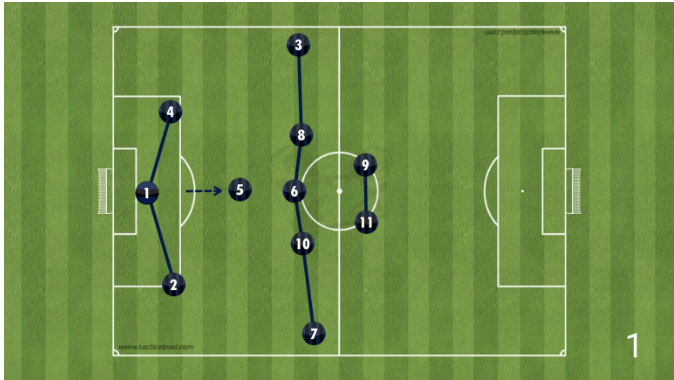
Defensively, Inter emphasise compactness and disciplined pressing, aiming to disrupt the opponent’s early build-up. The back three rotate according to Inzaghi’s principles, helping progression when the ball is theirs.
Build-up
Inter’s centre-backs are comfortable on the ball. In the first phase Hakan Çalhanoğlu drops into the back line, allowing one CB to step out while the wing-back on that side isolates himself to clear the lane. Data show Alessandro Bastoni makes the most progressive carries of any Inter defender—top 1 % among centre-backs.

A second rotation: Çalhanoğlu drops, another midfielder slides into a wide-CB role, the original wide CB converts to wing-back, and the original wing-back inverts inside to form a 2 v 1 with a striker.
Final Third Play
Two core principles for Inter are:
- Attack quickly
- Occupy space
Rather than “hover” around the box, Inter recycle deep—even back to goalkeeper Yann Sommer—to tempt the opponent’s line as high as possible. Once settled, rapid rotations aim at the dangerous space behind the line.

Inter’s movements reveal a squad of universal players:
- 1.Defenders attack forward consistently.
- * Midfielders and forwards initiate build-up and roam freely.
Third-man runs are the clearest example. In this example, Lautaro Martinez drops, pulling Marcus Thuram’s marker out; Thuram attacks the gap. Note the role reversal—usually Lautaro stays high while Thuram drops.
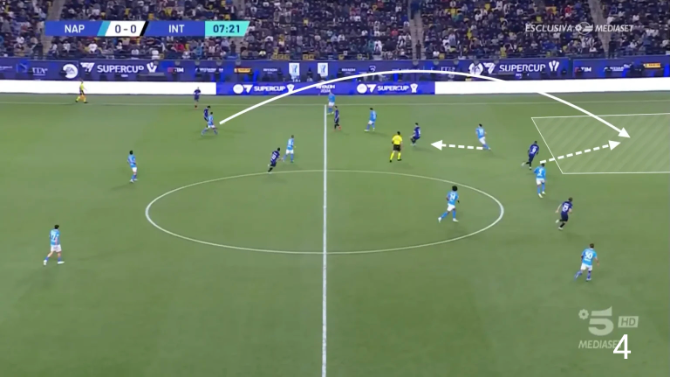
Pressing and Set Pieces
Inter are among Europe’s most successful set-piece sides thanks to aerial superiority and meticulous planning. For example a favourite right-side corner routine:
- Francesco Acerbi & Alessandro Bastoni attack the near post—either the ball itself or by dragging markers.
- Thuram drives the penalty spot.
- Lautaro starts deep, then bursts into the six-yard
- box for second balls and flick-ons.
- Benjamin Pavard waits outside for rebounds.
- Henrikh Mkhitaryan & Nicolo Barella set “screen blocks” to free at least one CB.

Left-side corners and free-kicks have entirely different setups.
Pressing
Without the ball Inter either drop to a low block or press high. In the high press Inzaghi prefers man-to-man. One CB—usually Bastoni—steps to a midfielder; that midfielder’s marker presses the full-back. They don’t mark too tightly, seeking central numerical superiority to avoid risky 1 v 1s.
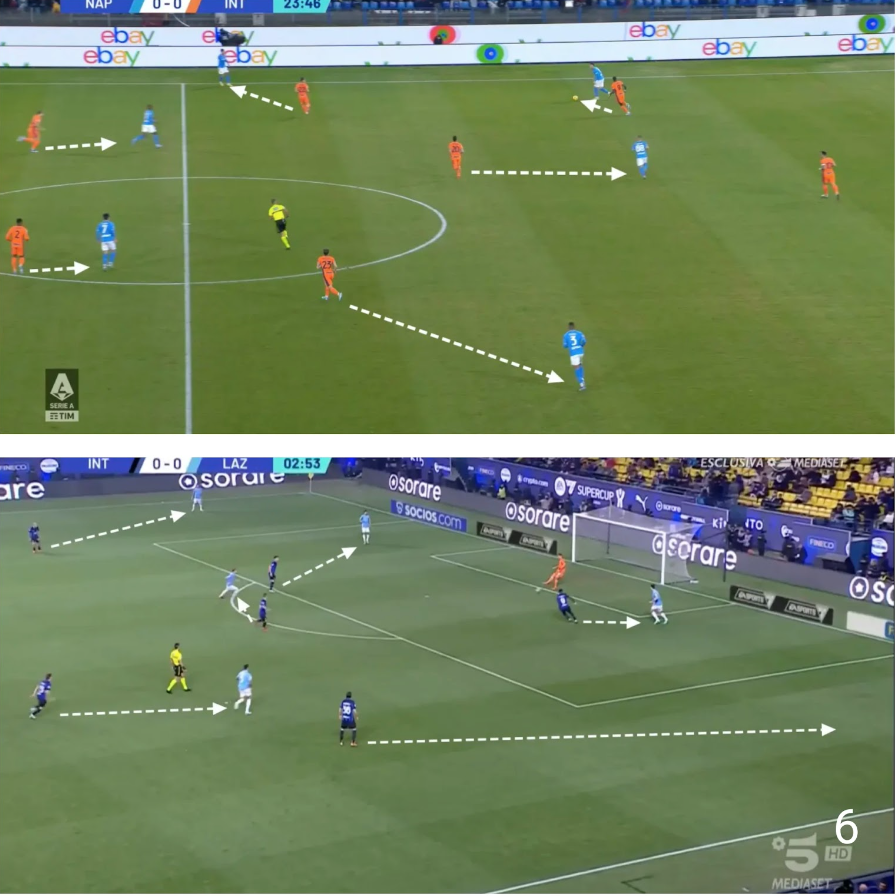
Offensive Transition
Inter’s transitions are about structure more than sheer speed, using positional superiority to exploit a disorganised opponent.
- Mkhitaryan is the connector.
- Hakan Çalhanoğlu drops, plays into Barella, Federico Dimarco, or Mkhitaryan, who then choose wide release or a slip to the strikers.
- Wing-backs: Denzel Dumfries is a box-crasher; Dimarco provides technique, often feeding an advanced Bastoni or the strikers.
- Strikers: Lautaro drags markers between lines; Thuram attacks the vacated space.

Defensive Transition
A major Inter strength. On losing the ball they execute “delay and drop”:
- Strikers and wing-backs delay the carrier.
- Midfielders drop into a 5-4 or 5-3. Çalhanoğlu blocks the central lane; Pavard steps up proactively if required.

PSG: Play Style
Structure and Positional Fluidity
PSG nominally start 4-3-3 but convert to 3-2-5 in possession. Vitinha tucks into the back line, Achraf Hakimi and Nuno Mendes push high to create wing space for the wingers, with Hakimi’s position tweaking the three-man backline.

Their forward line is highly mobile: Ousmane Dembélé often operates as a false nine, combining with Bradley Barcola. In the build-up, Vitinha is the deep-lying anchor, dictating tempo and distributing under pressure. Ahead of him sits Fabián Ruiz, the progressive left interior who frequently combines with Mendes and Khvicha Kvaratskhelia. On the right, JoãoNeves brings balance through inside runs and overlaps. Out of possession, PSG defend in a high 4-3-3 press; their technically rich squad sustains pressure even under duress.
Build-up Strategy
PSG focus on slow but vertical progression. With Vitinha dropped, full-backs advance and threaten consistently from wide areas. Short passes in midfield attract defenders before a sudden diagonal switch stretches the shape. From midfield, Neves looks for his winger with lofted passes—another attacking avenue. Build-up patterns include vertical one-twos, third-man combinations, and diagonal switches, especially targeting an isolated wide winger.
Final Third Play
PSG overload zones through quick rotations and third-man combos. Dembélé’s wide drift and Barcola’s inside run confuse defenders, creating chances for Kvaratskhelia. Hakimi and Mendes take up wide positions so the wingers can tuck inside. PSG’s aim is to manipulate the line via their full-backs, then interchange positions in the final third. Typically the full-backs deliver cut-backs or low crosses.
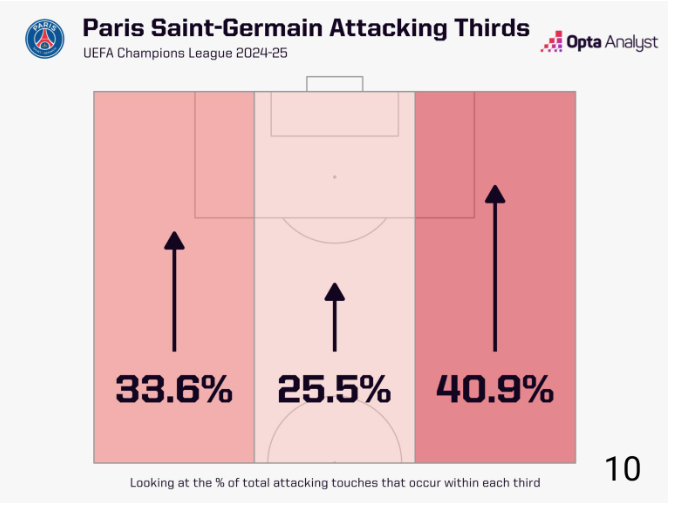
Set Pieces
PSG try to capitalise on three aerially superior players—Marquinhos, Willian Pacho, Fabián—so their routines are flexible.
- Marquinhos starts near post: shooting directly or flicking on.
- Pacho stations on the penalty spot.
- Mendes or Neves waits far post for flicks or loose balls.
- Outside the box stand Vitinha and Fabián, ready for first-time shots or possession regains

Offensive Transition
PSG are rapid and vertical, deadliest when opponents are disorganised. Barcola, Dembélé, and Kvaratskhelia overload wide areas to exploit half-spaces.
- Right side: Dembélé and Hakimi overlap into the final third.
- Left side: Nuno underlaps while Khvicha isolates his marker.
- Vitinha usually supplies third-man runs; if Neves stays deep, Fabián joins the second wave for diagonal passes or shots from the edge.
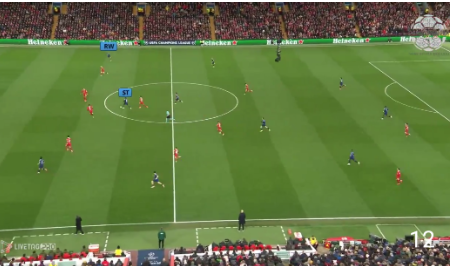
Defensive Transition
PSG’s critical weakness. Heavy wing play and forward roaming leave midfield gaps. When possession is lost they launch an immediate counter-press. Dembélé/Barcola harry the carrier; Vitinha tries to close nearby passing options. The action is reactive rather than fully structured.

Conclusion
By now, the contrasting approaches should be clear.
Inter can hurt PSG via multiple methods such as:
- Third-man runs that create separation between defenders
- Sommer’s long balls toward Thuram and Lautaro, followed by aggressive forward rotations
- Ability to exploit space behind the defensive line through coordinated movement
- Set-piece routines that generate high-quality chances
- Positional balance and midfield stability during offensive and defensive transitions
PSG can cause damage to Inter by:
- Explosiveness in attacking transitions
- 1 v 1 dribbling threat, especially from Dembélé, Barcola, and Kvaratshkelia
- High unpredictability in final-third actions through rotations and overloads
- Overloading the flanks against Inter’s five-man backline, forcing narrow shifts
- Moments of individual brilliance that can change the game flow suddenly
In an open, back-and-forth game, PSG’s flair and chaos could unsettle Inter early. But over the full 90 minutes, Inter’s composure, structure, and strategic variety might allow them to take control. My prediction: Inter Milan to win the 2024-25 UEFA Champions League trophy, based on:
- Better in speed-plus-breakaway moments
- More solid defensively
- Superior midfield control
- Clearer set-piece threat
- Greater big-match discipline
The one crucial factor favouring PSG? The “X-factor” of sheer talent. In football anything can happen: PSG’s star power could clinch it, or Inter’s tactical discipline could prevail.
Featured Image: @GabFoligno / ANP / Getty Images
